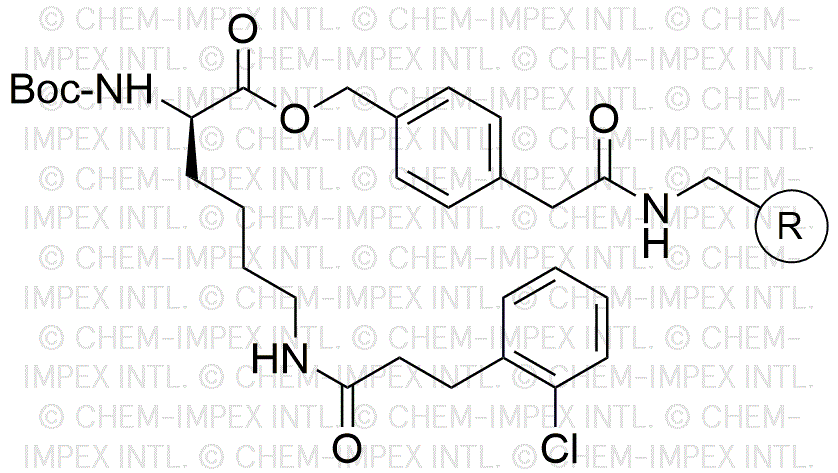Na-Boc-Ne-2-chloro-Z-D-lysine 4-oxymethylphenylacetamidomethyl is widely utilized in research focused on:
- Peptide Synthesis: This compound serves as a key building block in the synthesis of peptides, enabling researchers to create specific sequences for various biological studies.
- Drug Development: It plays a crucial role in the pharmaceutical industry for developing novel therapeutics, particularly in targeting specific proteins or enzymes.
- Bioconjugation: The compound is used in bioconjugation processes, allowing for the attachment of drugs to antibodies or other biomolecules, enhancing drug delivery systems.
- Research on Protein Interactions: It aids in studying protein interactions and modifications, providing insights into cellular mechanisms and disease pathways.
- Custom Chemical Libraries: Researchers utilize it to create diverse chemical libraries for high-throughput screening, facilitating the discovery of new compounds with desired biological activities.
General Information
Properties
Safety and Regulations
Applications
Na-Boc-Ne-2-chloro-Z-D-lysine 4-oxymethylphenylacetamidomethyl is widely utilized in research focused on:
- Peptide Synthesis: This compound serves as a key building block in the synthesis of peptides, enabling researchers to create specific sequences for various biological studies.
- Drug Development: It plays a crucial role in the pharmaceutical industry for developing novel therapeutics, particularly in targeting specific proteins or enzymes.
- Bioconjugation: The compound is used in bioconjugation processes, allowing for the attachment of drugs to antibodies or other biomolecules, enhancing drug delivery systems.
- Research on Protein Interactions: It aids in studying protein interactions and modifications, providing insights into cellular mechanisms and disease pathways.
- Custom Chemical Libraries: Researchers utilize it to create diverse chemical libraries for high-throughput screening, facilitating the discovery of new compounds with desired biological activities.
Documents
Safety Data Sheets (SDS)
The SDS provides comprehensive safety information on handling, storage, and disposal of the product.
Product Specification (PS)
The PS provides a comprehensive breakdown of the product’s properties, including chemical composition, physical state, purity, and storage requirements. It also details acceptable quality ranges and the product's intended applications.
Certificates of Analysis (COA)
Search for Certificates of Analysis (COA) by entering the products Lot Number. Lot and Batch Numbers can be found on a product’s label following the words ‘Lot’ or ‘Batch’.
*Catalog Number
*Lot Number
Certificates Of Origin (COO)
This COO confirms the country where the product was manufactured, and also details the materials and components used in it and whether it is derived from natural, synthetic, or other specific sources. This certificate may be required for customs, trade, and regulatory compliance.
*Catalog Number
*Lot Number
Safety Data Sheets (SDS)
The SDS provides comprehensive safety information on handling, storage, and disposal of the product.
DownloadProduct Specification (PS)
The PS provides a comprehensive breakdown of the product’s properties, including chemical composition, physical state, purity, and storage requirements. It also details acceptable quality ranges and the product's intended applications.
DownloadCertificates of Analysis (COA)
Search for Certificates of Analysis (COA) by entering the products Lot Number. Lot and Batch Numbers can be found on a product’s label following the words ‘Lot’ or ‘Batch’.
*Catalog Number
*Lot Number
Certificates Of Origin (COO)
This COO confirms the country where the product was manufactured, and also details the materials and components used in it and whether it is derived from natural, synthetic, or other specific sources. This certificate may be required for customs, trade, and regulatory compliance.


